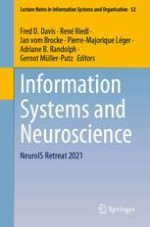2021 | Buch
Information Systems and Neuroscience
NeuroIS Retreat 2021
herausgegeben von: Prof. Dr. Fred D. Davis, Prof. Dr. René Riedl, Prof. Dr. Jan vom Brocke, Prof. Dr. Pierre-Majorique Léger, Prof. Dr. Adriane B. Randolph, Prof. Dr. Gernot Müller-Putz
Verlag: Springer International Publishing
Buchreihe : Lecture Notes in Information Systems and Organisation
